Page 100 of 340
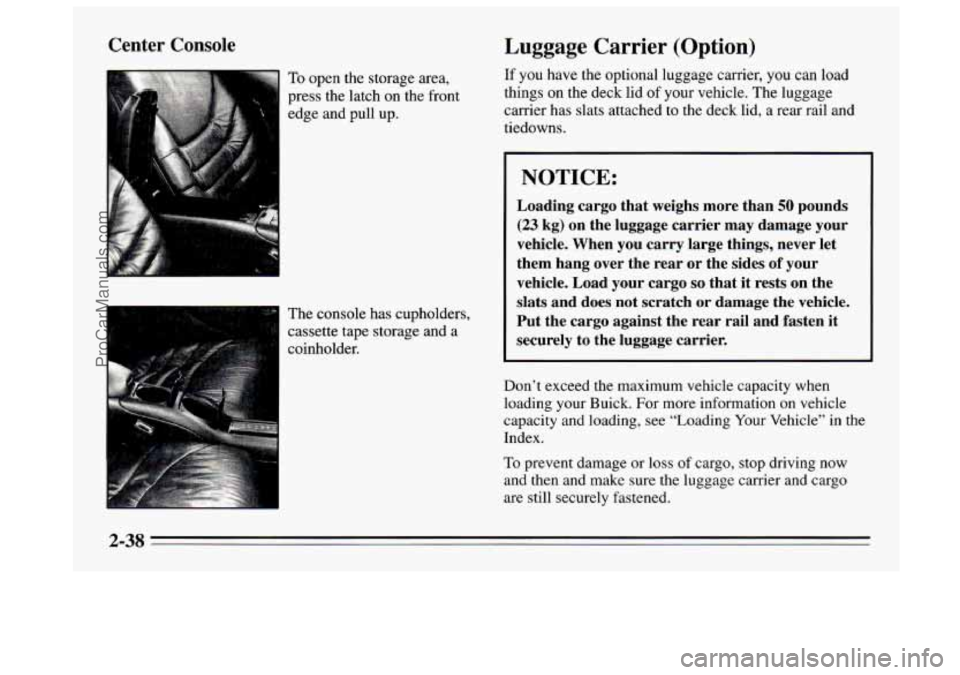
Center Console
To open the storage area,
press the latch
on the front
edge and pull up.
The console has cupholders,
cassette tape storage and a
coinholder.
Luggage Carrier (Option)
If you have the optional luggage carrier, you can load
things on the deck lid
of your vehicle. The luggage
carrier has slats attached to the deck lid, a rear rail and
tiedowns.
NOTICE:
Loading cargo that weighs more than 50 pounds
(23 kg) on the luggage carrier may damage your
vehicle. When you carry large things, never let
them hang over the rear
or the sides of your
vehicle. Load your cargo
so that it rests on the
slats and does not scratch
or damage the vehicle.
Put the cargo against the rear rail and fasten it
securely to the luggage carrier.
Don’t exceed the maximum vehicle capacity when
loading your Buick. For more information on vehicle
capacity and loading, see “Loading Your Vehicle”
in the
Index.
To prevent damage or loss of cargo, stop driving now
and then and make sure the luggage carrier and cargo
are still securely fastened.
2-38
ProCarManuals.com
Page 164 of 340
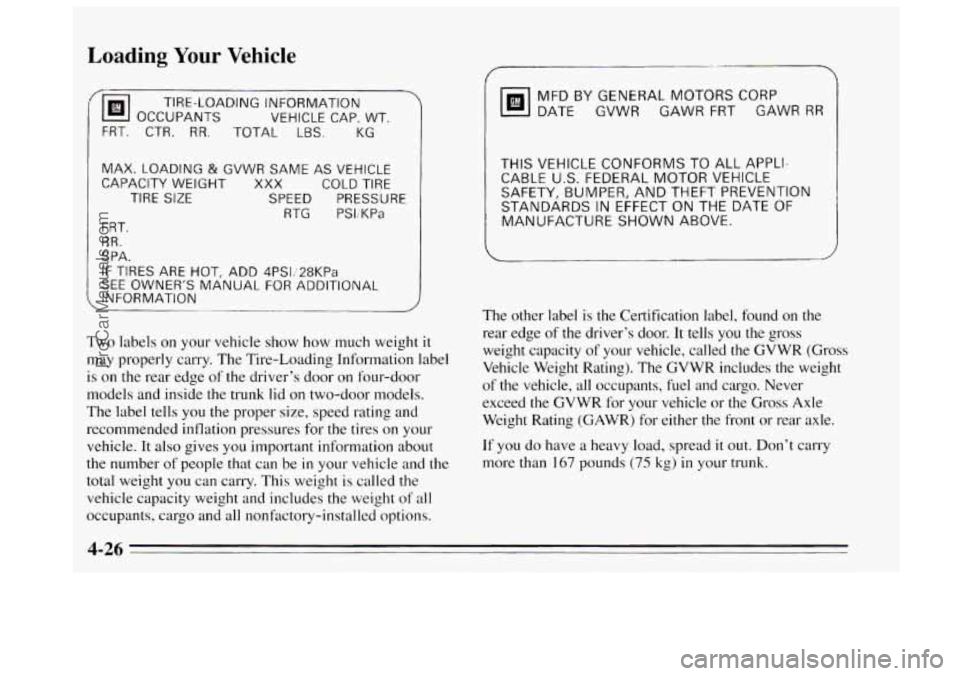
Loading Your Vehicle
OCCUPANTS VEHICLE CAP. WT.
TIRE-LOADING INFORMATION
I FRT. CTR. RR.
TOTAL LBS. KG
MAX.
LOADING & GVWR SAME AS VEHICLE
CAPACITY WEIGHT XXX COLD TIRE
TIRE
SIZE SPEED PRESSURE
RTG
PSIiKPa
FRT.
RR.
SPA.
IF TIRES ARE HOT, ADD 4PSIj28KPa
SEE OWNER’S MANUAL FOR ADDITIONAL
INFORMATION
- ~-__I__-__ -d
Two labels on your vehicle show how much weight it
may properly carry. The Tire-Loading Information label
is on the rear edge of the driver’s door on four-door
models and inside the trunk lid on two-door models.
The label tells you the proper size, speed rating and
recommended inflation pressures for the tires on your
vehicle. It
also gives you important information about
the number of people that can be
in your vehicle and the
total weight you can carry. This weight is called the
vehicle capacity weight and includes the weight of
all
occupants, cargo and all nonfactory-installed options.
/ -- -7
MFD BY GENERAL MOTORS CORP
DATE GVWR GAWR FRT GAWR RR
I
THIS VEHICLE CONFORMS TO ALL APPLI-
CABLE
U.S. FEDERAL MOTOR VEHICLE
SAFETY,
BUMPER, AND THEFT PREVENTION
STANDARDS
IN EFFECT ON THE DATE OF
MANUFACTURE SHOWN ABOVE.
1
The other label is the Certification label, found on the
rear edge of the driver’s door. It tells you the gross
weight capacity of your vehicle, called the GVWR
(Gross
Vehicle Weight Rating). The GVWR includes the weight
of the vehicle, all occupants, fuel and cargo. Never
exceed the GVWR for your vehicle or the Gross Axle
Weight Rating (GAWR) for either the front or rear axle.
If you do have a heavy load, spread
it out. Don’t carry
more than
167 pounds (75 kg) in your trunk.
4-26
ProCarManuals.com
Page 166 of 340
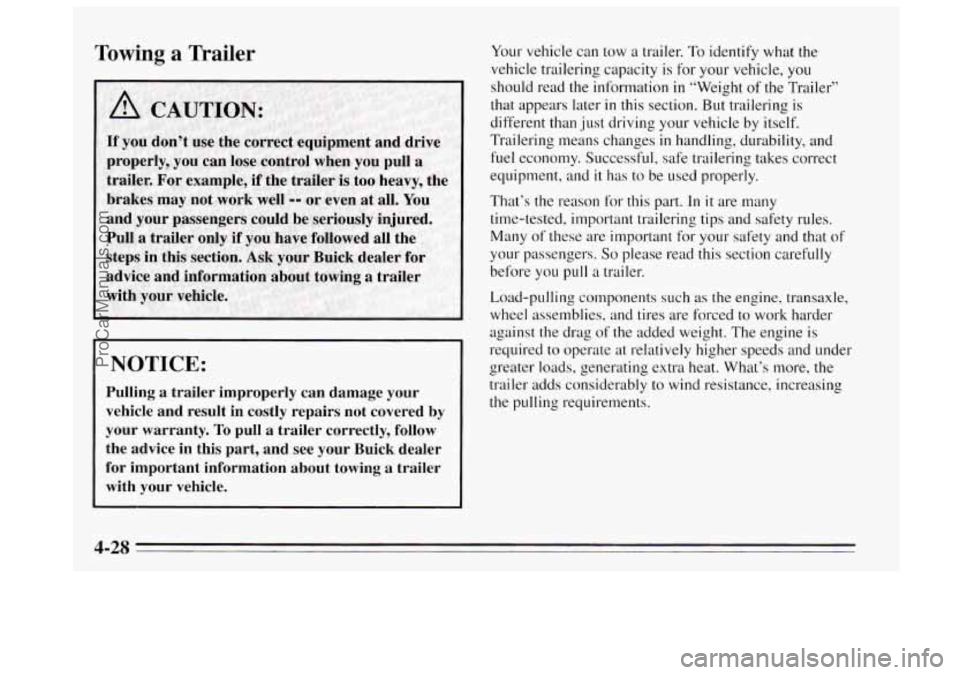
Towing a Trailer
advice and information about towing a trailer
with your vehicle.
I’
~ NOTICE:
~ Pulling a trailer improperly can damage your
vehicle and result in costly repairs not covered by
~ your warranty. TO pull a trailer correctly, follow
the advice in this part, and see your Buick dealer
for important information about. towing a trailer
with your vehicle. Your
vehicle can tow a trailer.
To identify what the
vehicle trailering capacity is for your vehicle,
you
should read the information in “Weight of the Trailer”
that appears later
in this section. But traiiering is
different than just driving your vehicle by itself.
Trailering means changes
in handling, durability, and
fuel economy. Successful, safe trailering takes correct
equipment, and
it has to be used properly.
That’s the reason for this part.
In it are many
time-tested, important trailering tips and safety rules.
Many of these are important for your safety and that of
your passengers.
So please read this section carefully
before you pull
a trailer.
Load-pulling components such
as the engine, transaxle,
wheel assemblies, and tires are forced to work harder
against the drag of the added weight. The engine is
required
to operate at relatively higher speeds and under
greater loads, generating extra heat. What’s more, the
trailer adds considerably to wind resistance. increasing
the pulling requirements.
4-28
ProCarManuals.com
Page 168 of 340
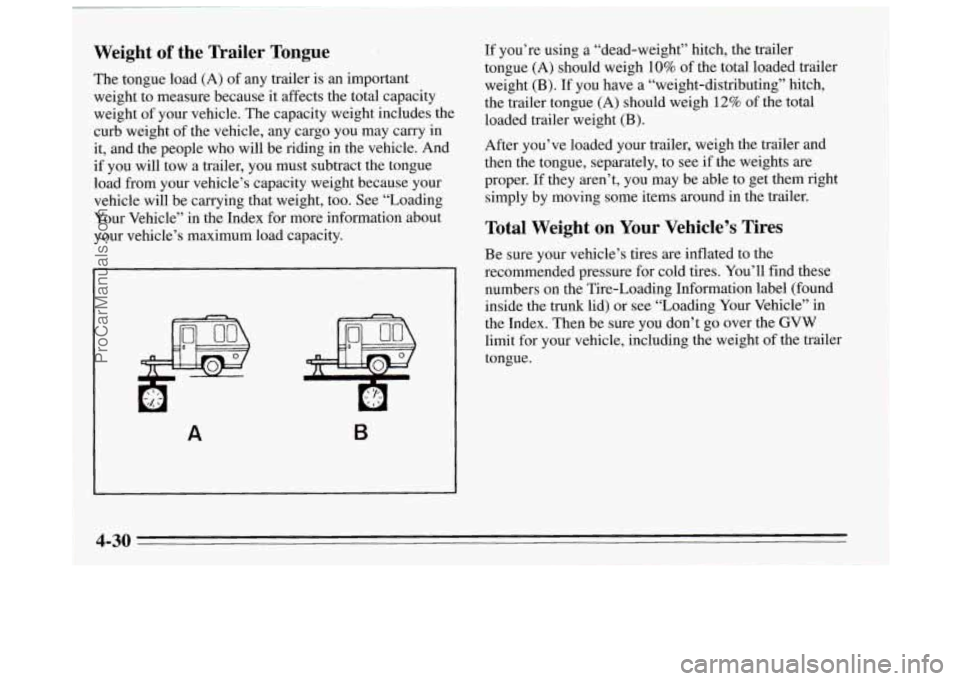
Weight of the Trailer Tongue
The tongue load (A) of any trailer is an important
weight to measure because it affects the total capacity
weight of your vehicle. The capacity weight includes the
curb weight of the vehicle, any cargo you may carry in
it, and the people who will be riding in the vehicle. And
if you will tow a trailer, you must subtract the tongue
load from your vehicle’s capacity weight because your
vehicle will be carrying that weight, too. See “Loading
Your Vehicle” in the Index for more information about
your vehicle’s maximum load capacity.
A B
If you’re using a “dead-weight” hitch, the trailer
tongue (A) should weigh
10% of the total loaded trailer
weight
(B). If you have a “weight-distributing” hitch,
the trailer tongue
(A) should weigh 12% of the total
loaded trailer weight (B).
After you’ve loaded your trailer, weigh the trailer and
then the tongue, separately, to see if the weights
are
proper. If they aren’t, you may be able to get them right
simply by moving some items around in the trailer.
Total Weight on Your Vehicle’s Tires
Be sure your vehicle’s tires are inflated to the
recommended pressure for cold tires. You’ll find these
numbers on the Tire-Loading Information label (found
inside the trunk lid) or see “Loading Your Vehicle” in
the Index. Then be sure you don’t go over the
GVW
limit for your vehicle, including the weight of the trailer
tongue.
4-30
ProCarManuals.com
Page 244 of 340
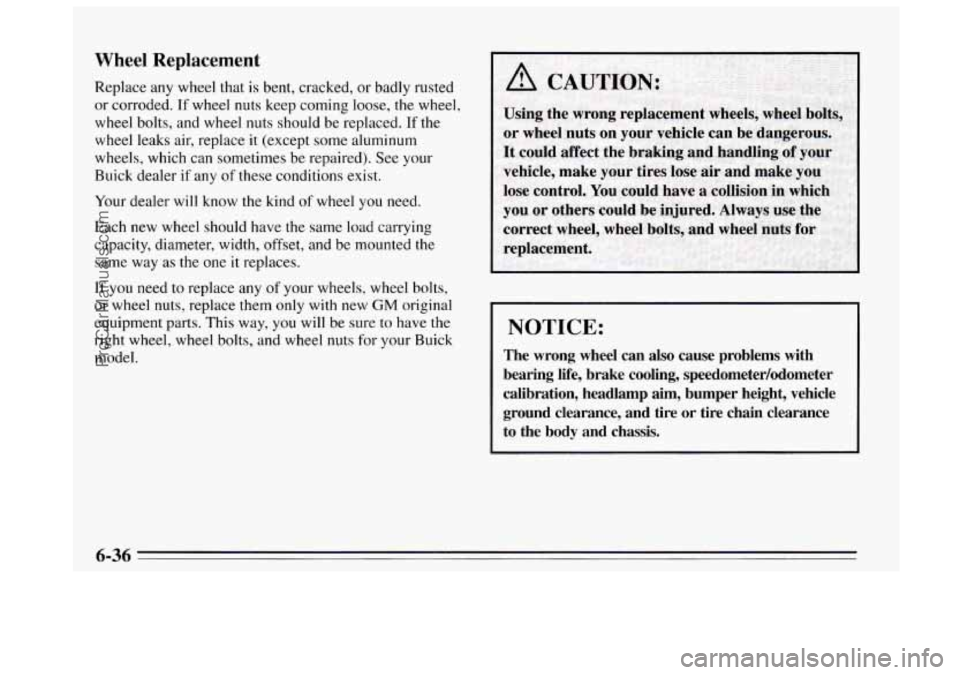
Wheel Replacement
Replace any wheel that is bent, cracked, or badly rusted
or corroded. If wheel nuts keep coming loose,
the wheel,
wheel bolts, and wheel nuts should be replaced. If
the
wheel leaks air, replace it (except some aluminum
wheels, which can sometimes be repaired). See your
Buick dealer
if any of these conditions exist.
Your dealer will know the kind
of wheel you need.
Each new wheel should have the same load carrying
capacity, diameter, width, offset, and be mounted
the
same way as the one it replaces.
If you need to replace any of your wheels, wheel bolts,
or wheel nuts, replace them only with new
GM original
equipment parts. This way, you will be sure to have
the
right wheel, wheel bolts, and wheel nuts for your Buick
model. NOTICE:
The wrong wheel can also cause problems with
bearing life, brake cooling, speedometer/odometer
calibration, headlamp aim, bumper height, vehicle
ground clearance, and tire or tire chain clearance
to the body and chassis.
ProCarManuals.com